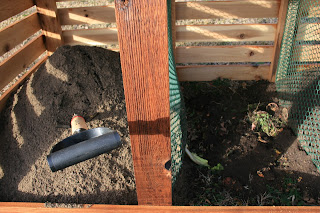Spring roses starting to bloom!
Alright, rock and roll! We got something to blog about ... two success items, one problem, and a bonus item.
One thing I've been trying to figure out is how to stake the tomatoes in the square foots. I didn't think traditional cages would work because you can't stake them into the ground due to the bottom on the square foot. Even if I swiveled them into the bottom, I was afraid a strong wind would knock them over, including my plants. I also considered drilling a hole and hammering in a 4' rebar for each and somehow attaching them that way, but it seemed like a very inefficient method and the tomatoes would have to go in the same spot every year.
My solution was to go ahead and make small cages, like the traditional ones, that would fit in each square foot. Then I swiveled them into the dirt an inch or two over the tomato plants. Then I hammered the 4' rebar into the ground on each side of the square foot for one row of tomatoes. Using any kind of old wire I could find, I anchored the cages to the rebar by threading and looping the wire through the tops of the cages, like so:
The wire is looped around each side of the cage.
The test for my solution came that very night when we had thunderstorms all night with high winds. They did not budge! I wish you could wiggle the cages, something I can't show you in a picture, but they are all taught and sturdy between those rebar.
Single row of caged tomatoes.
Double row of caged tomatoes.
My second success is how to efficiently water my gardens. Before, I had a hose drug from the back of the house which the lawn service had to move around and I had to drag it back to the house if I needed it there. Or, I hand carried water from the pond, very tedious in 95 degree Texas weather. I decided to use the pump that is next to the pond. We have a french drain that gathers runoff from our northerly neighbor and it fills a reservoir, which has a pump to kick the water into the pond. We attached a hose to the pump, so now I could water them from the pond, but I still had a hose in the yard:
Trench prepared for the hose.
This disagreed with my meticulous upbringing, so I made a trench and buried the hose over to the compost bin. Then attached a hose reel to the bin with another hose that had a shut off valve. When I need to water the square foots, I turn on the valve at the pump, turn the valve at the compost bin, and off I go! My only problem now is that instead of purchasing the NeverKink hose, I bought the GuaranteedToKink hose. Avoid my mistake :)
My next problem is bugs. Something is eating my basil and greens that are trying to come up. I'm planning on starting with a spray bottle of just liquid soap and water and go from there. I also noticed that one of my potato plants is getting black spots, so I need to figure that out, too. Some of my plants don't look quite as green as I think they should and I probably need to start learning about organic fertilizer. I did use some Miracle Grow because I had some, but I want to get the skinny on fertilizing.
For your bonus, I've got some pictures of my back garden that is starting to bloom. I built this garden by hand in the summer of 2005 and actually had an article about it in the Fort Worth Star Telegram. It is an English style garden designed by my mother with a small pond and patio in the evening shade, something that is welcome on hot Texas summer evenings. It needs some updating work, but it still surprises me how it comes to life in the spring. Enjoy!
Path from the back patio, aazaleas and hostas.
Small patio on the left, newly reworked herb bed to the right.
Pond between two Japanese maples.





















































